Mladen and Del review ‘John Wick Chapter 3 – Parabellum’
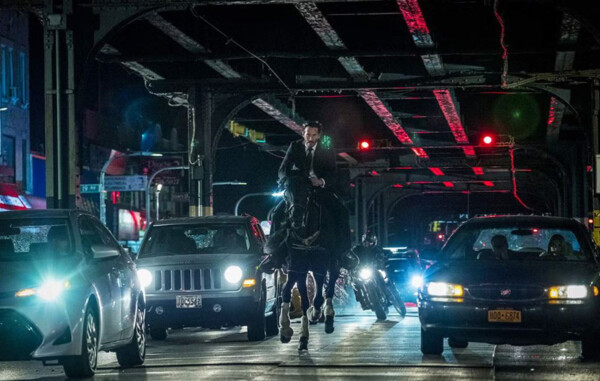
Image courtesy of Lionsgate Home Entertainment.
“John Wick Chapter 3 – Parabellum” Starring Keanu Reeves, Halle Berry, Ian McShane, Laurence Fishburne, and Asia Kate Dillion. Directed by Chad Stahelski. 130 minutes. Rated R.
Mladen’s take
John Wick and I are a lot alike, if the essence of freshly released film, “John Wick: Chapter 3 – Parabellum,” is the yardstick. John’s life and work in “Wick 3” are hampered by all sorts of rules, procedures, constraints and layers of management. I face those same obstacles daily.
Of course, there’s a difference between being a celebrity assassin in a wildly popular movie franchise and my often frustrating effort to keep health insurance for my family, a roof over our heads, and our cars running. I am leashed to others. Wick is not, unless he chooses to be. What the director chose for John in “Wick 3” was to leash him to the memory of his dead wife, which, thankfully, leads from one glorious scene of hyperviolence to another. But, that choice also produced a couple of chinks in the armor of the formidably entertaining Wick saga.
“Wick 3” is merely a good movie and the weakest in the franchise because of two problems, one with the story and the other with an important character.
“Wick 3” should’ve been more like its two predecessors, an intimate tale of personal redemption or, at least, a movie with a good excuse for all those heads getting blown apart and dogs attacking men’s groins. In Wick 1 we see John addressing very personal slights – a dead puppy and a stolen muscle car. I can sympathize with both. In Wick 2 he’s a hesitant, duty-bound killer honoring a marker. In those movies, John wanted out of the assassin racket. In “Wick 3,” he wants back in to stay alive to remember his wife, but changes his mind later. That wishy washiness is unbecoming of the planet’s most accomplished hitman. In Wicks 1 and 2 we see that it’s the world’s fault for keeping John a servant of the High Table, the gang of 12 thugs running Earth’s underworld. Bad people don’t leave John alone, so he has to defend himself, his property and his memories to impose order. Because of his do-rightness he, himself, is rendered ex communicado persona non grata for whacking a mob boss inside a hotel. In Wick 3, the HOTEL is punished by being “deconsecrated.”
On top of blacklisting a hotel, “Wick 3” offers other tidbits of bureaucratic and legalistic nonsense such as the notion of “fealty” to the High Table and the High Table’s dispatch of an “adjudicator” to settle its score with John and anyone who has helped him. “Wick 3” begins to meander, including a dip into mysticism, as a result. Of all the characters flowing through “Wick 3,” the adjudicator is the most frustrating. She is supposed to be a prim and proper bad ass representing the High Table’s interest, which is to keep everyone in line to make sure crime and profit go uninterrupted by rule breakers such as John. Instead, the adjudicator is a meek, stiff, uncharismatic, unintentionally droll and unconvincing enabler of the High Table’s will. Yes, the adjudicator’s flimsiness is somewhat offset by the strong female character, Sofia, in “Wick 3,” but damage to the story had already occurred by the time she’s introduced. The High Table and the adjudicator, instead of seeming to be all powerful, just seemed to be on their way toward stepping into John’s line of fire which, I suspect, will be the plot of “Wick 4.”
“Parabellum” is a dead language’s phrase for “prepare for war.” When you go see “Wick 3,” prepare to be disappointed. “Wick 3” lacks the emotional grit and gristle of Wicks 1 and 2. “Wick 3’s” bad girl is particularly unsatisfying and the film’s High Table assassin, campy. The weak motivation for “Wick 3’s” hyperviolence renders it something approaching gratuitous. I hope “Wick 4” corrects that weakness or Wick world-building will go the way of Star Wars. “Wick 3” gets a B from me. See it in a theater with vibrant projection and good sound.

Del’s take
Once upon a time there was a little movie about an undercover cop who infiltrated a car theft ring to bust the ringleader. That little movie, “The Fast and the Furious,” made the late Paul Walker a star and provided Vin Diesel with a hit on his resume.
So they made a sequel.
Then another.
Then another, where they rebooted the series.
Then another.
And another, ad finitum.
Each of those sequels required more action, bigger plots and higher stakes than its predecessor, until now Lamborghinis are being chased by nuclear submarines and Ferraris tossed from cargo planes as the “Fast and Furious” crew saves the world from (name your favorite apocalyptic nemesis).
In other words, silly.
Unfortunately that’s the trajectory being followed by the John Wick saga. What started as a personal and, dare I say, charming story of revenge by a man whose puppy got shot and his car stolen, is slowly evolving into something I no longer recognize – a bastard child of James Bond and “The Matrix.”
I don’t like it. I want the old John Wick.
That’s not to say “Parabellum” is a bad movie. It’s just not what I expected, and as Mladen pointed out, it deviated in ways I don’t think will work.
(FYI: Mladen is nothing like John Wick. I’ve never seen him chop off a person’s head with a samurai sword and he doesn’t even like dogs.)
The plot careens along as Mladen described it. I’ll further explain it picks up where the second movie left off, with Wick and his pit bull running for their lives after the ruling elite of the assassins’ guild, something called the High Table, excommunicates him and puts a price on his head. Every other phone on the street is ringing with the news that Wick’s bounty stands at a cool $14 million, which makes you wonder how all those killers manage to operate without putting each other in the unemployment line. There are THAT many. Think about it next time you’re in a crowded grocery store.
The methods of death are inventive and graphic. If I had to choose a favorite it would be Wick slapping a horse on the ass and the horse kicking an assassin into a wall, dispatching him to that great Died of a Horse Kicking paddock in the sky.
Mladen described the action as hyperviolent and he’s not exaggerating. Apart from a few slogs through muddy pacing in the second act, the movie is almost nonstop violence with people getting shot, chopped, sliced, diced, kicked, burned, or having their genitalia ripped out by vicious German Shepherds.
It was cool to see Keanu Reeves on the screen once again with Laurence Fishburne, and it was disappointing that Halle Berry’s role was so small. For Christ’s sake, she’s an Oscar winner. Put her to work.
Maybe she could have done a better job than Asia Kate Dillion as the Adjudicator, who came across as Mladen described: devoid of menace. And Keanu? Well, what can I say? Keanu was Keanu. He’s never had a lot of dialogue in these movies and “Wick 3” is no exception.
My big gripe is with the direction the movie took, with its emphasis on the worldwide mystery cult of assassins and all their rules, talismans and functionaries. It was like watching a tiger team of GS-12s stumble upon a cache of Uzis. It carries the Wick saga farther afield from its humble origins, from a man with a grudge who has payback on his mind into some kind of mystical figure fate has anointed with special powers. Maybe they should change his name to Neo Wick.
The action is exquisitely choreographed and the special effects spot on, but beware: “Wick 3” is a bloodbath, and it’s probably not what you were expecting after having watched the previous iterations.
There’s a sequel coming and I’ll likely see it. But it may be the last time I bump into John Wick in a movie theater. I like my action movies smart, not silly.
I give it a B.
Mladen Rudman is a former journalist and technical writer. Del Stone Jr. is a former journalist and author.
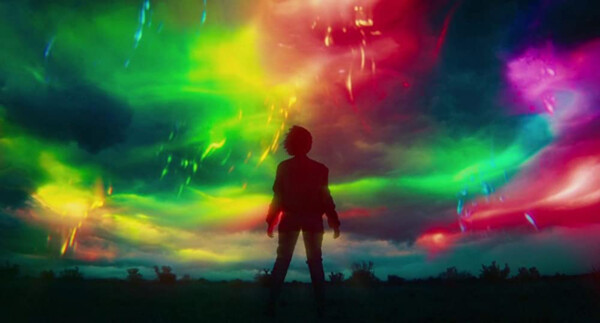
Image courtesy of Lionsgate.
“Fast Color” Starring Gugu Mbatha-Raw, Christopher Denham, Lorraine Toussaint and Sanniya Sidney. Directed by Julia Hart. 100 minutes. Rated PG-13. Hulu.
Del’s take
“Fast Color” is pitched as a superhero movie but it is unlike any superhero movie you’ve ever seen, and I would venture to say it is not a superhero movie at all but a story about three women battling forces, both seen and not, that isolate them from the world but bind them as a family.
It is also one of those quiet, semi-science fiction dramas that slip into and out of the stream of pop entertainment garbage so noiselessly that it will not be noticed unless somebody draws attention to it.
As I watched “Fast Color” I thought of Zenna Henderson’s series of books about The People, immigrant aliens who arrive at Earth after their own world is destroyed. I also thought of the Tim Robbins movie “Code 46,” which also came and went without much fanfare but was a fine, overlooked gem of a film.
In “Fast Color,” Ruth (Gugu Mbatha-Raw) is a mother on the run, pursued by Bill (Christopher Denham), a government scientist eager to exploit Ruth’s psychokinetic abilities to cause earthquakes during the seizures that wrack her body. Ruth flees to her mother Bo’s (Lorraine Toussaint) home where Ruth’s daughter Lila (Sanniya Sidney) lives. Bo is raising Lila because Ruth is broken, a poetic way of saying she’s been struggling with substance addiction and other issues. Bo and Lila also have powers – they can take things apart and put them back together. But something that’s broken? It can’t be fixed – not by their telekinetic powers, at any rate.
That theme of brokenness operates throughout “Fast Color” – in Ruth by her moral flaws, Bo by her inability to fix Ruth and even Lila for her life of concealment, something every gay man and woman on the face of the Earth already understands. The government is broken, usually the case in movies where it is made the antagonist, and even the Earth is broken with climate change rendering water a commodity so precious America’s standard of living has descended to something that resembles the Third World.
The movie also tells us that while magic cannot fix things already broken, love may find a way. As the story winds toward its resolution we see Ruth, Bo and Lila seeking their own paths to redemption, with nary a caped crusader, death ray or dollop of the-fate-of-the-universe-lies-in-their-hands bullshit thrown in for dramatic tension.
The movie unfolds at a languid pace, which I felt was sometimes too slow, and reveals its secrets along the way requiring a patient audience. Its scope is limited and simultaneously expansive as it, like “Nomadland,” is set in the parched Southwest with its infinite horizons and empty landscapes.
The best performance of the film – and many of them are good – was by Toussaint as the suffering mother/grandmother Bo. She brought a regal dignity to the role and succeeded in avoiding the clichés and tropes of the put-upon matriarch who would suffer to spare her children.
I did not like the way Hart chose to end the film as it tended to confirm some of those clichés repudiated by everything that led up to the climax – in fact, the climax seemed more of an anticlimax and could have been reworked to provide more subtextual pop.
Still, “Fast Color” will entertain for its 100 minutes and it’s a good antidote to a lot of the nonsense that passes for science fiction in cinema these days.
I would grade it at a B+.

Mladen’s take
I enjoyed “Fast Color,” though it is incorrectly billed, as Del correctly noted.
That the streaming service, producers, studio, whoever or whatever, tried to sucker me with the claim the film is a science fiction adventure doesn’t bother me too much. “Fast Color” is a good, girl relationships movie with occasional doses of a superpower on exhibit. The superpower, by the way, comes in two flavors: controllable by its practitioner or beyond control.
The three women in the film have brains with the capability to deconstruct and reconstruct objects. When our heroines explode objects into millions of sand grain pieces and return those grains to their original uniform form, the process comes with bright, streaking stripes of color.
Best as I can tell, our heroines use the word “color” in their conversations as code for their power. “She sees colors.” “I can’t see colors.” “Does anyone else beside us three see colors?”
Bo, Ruth, and Lila have to talk carefully because they recognize that there are a whole bunch of people on the rain-starved Earth of the future who would try to weaponize their telekinesis, rather than do good with it.
Also, best as I can tell, our heroines are mortal. So, they could be snubbed by the Government if deemed a threat or some Trump-loving nationalistic fascist racist patriot citing God as his source of inspiration and authorization to cancel from the world the un-godly as he defines them.
Personally, though, had I fast color, I wouldn’t be cowering from the billions of stupid people on this planet. I’d discern ways to let those reds, greens, and blues rip to achieve world peace while I worked toward enabling the power to allow me to live forever so that I could travel to edge of the universe.
I can’t recall the soundtrack for “Fast Color,” which is good and bad. Bad in the sense that the score, at least to me, failed to add to the film. Good in that the music didn’t distract the plot. I did enjoy the song about a new day coming about halfway through the film.
“Fast Color” has a pleasantly subdued dystopian feel. The world is dry as in “Mad Max: Fury Road,” but there’s no hyperviolence among warring tribes. In fact, there’s very little violence in “Fast Color.” The director conveys desperation and dearth by showing poor pickins’ on store shelves. More effective is the unceasing reminder that the water well is going dry. Water is ladled into and out of plastic containers marked with red for maximum volume, usually about half of the actual capacity of a jug. There must be no spillage. Check into a motel and you pay for the room and the water. Faucets are useless, bathing wasteful.
However, the reason I give “Fast Color” a B+ like Del is this: Though essentially a girl movie, there’s almost no romance. The lack of romance allows me to forgive the studio for lying about the film’s true genre.
Mladen Rudman is a former journalist and technical writer. Del Stone Jr. is a former journalist and author.

Image courtesy of Del Stone Jr.
I visited Santa Rosa Mall the other day. It was sad.
Sears was shuttered. I almost never shopped there unless I needed a belt. Sears always had a large selection of belts for guys with beer guts like yours truly.
When we were kids we looked forward to the arrival of the Sears catalog. I would pore over the toy section, dreaming of the airplanes, slot car racers and train sets that rumbled across those pages.
No, we never used it for toilet paper. But our parents probably did.
Belk has been closed many years. They had cool shirts and those wonderful Polo towels I still use. But I hated their mirrors. I would try on a new pair of pants or shorts, look in the mirror and hate what looked back at me.
The food court is a pale shadow of its former self. A few restaurants cling to existence, but it’s nothing like it used to be.
I miss the bookstore, theater and arcade. I miss the crowds that thronged its concourses. I miss going into the music store and browsing the CDs while Thompson Twins and “Into the Groove” played from overhead speakers.
I grieve for the mall, and I can’t understand what has happened — not just to it but people, too. Why would people rather visit a strip shopping center, or shop online? It’s an absolute pain in the you-know-what to return a pair of shoes you ordered from an online store and they don’t fit.
I have written about what the mall could become — a “mall” of medical facilities and doctors, for instance. But one community in Bristol, Virginia, came up with a novel solution I know would work here.
Two developers are turning their town’s mall into a casino, hotel and convention center.
The casino is to be situated in one of the empty anchor stores while the remainder is occupied by hotel rooms, a children’s area with swimming pools, restaurants and retailers.
They expect this complex to bring in 2,000 jobs at the outset, growing to 5,000 with an average annual income of $46,000.
Think of it: Jobs, income for Mary Esther, more money for the state and a revival of a once thriving center of commerce. The state would have to change its laws, but that’s not an impossible obstacle.
Why not roll the dice on a casino?
About the author:
Del Stone Jr. is a professional fiction writer. He is known primarily for his work in the contemporary dark fiction field, but has also published science fiction and contemporary fantasy. Stone’s stories, poetry and scripts have appeared in publications such as Amazing Stories, Eldritch Tales, and Bantam-Spectra’s Full Spectrum. His short fiction has been published in The Year’s Best Horror Stories XXII; Alfred Hitchcock’s Mystery Magazine; the Pocket Books anthology More Phobias; the Barnes & Noble anthologies 100 Wicked Little Witch Stories, Horrors! 365 Scary Stories, and 100 Astounding Little Alien Stories; the HWA anthology Psychos; and other short fiction venues, like Blood Muse, Live Without a Net, Zombiesque and Sex Macabre. Stone’s comic book debut was in the Clive Barker series of books, Hellraiser, published by Marvel/Epic and reprinted in The Best of Hellraiser anthology. He has also published stories in Penthouse Comix, and worked with artist Dave Dorman on many projects, including the illustrated novella “Roadkill,” a short story for the Andrew Vachss anthology Underground from Dark Horse, an ashcan titled “December” for Hero Illustrated, and several of Dorman’s Wasted Lands novellas and comics, such as Rail from Image and “The Uninvited.” Stone’s novel, Dead Heat, won the 1996 International Horror Guild’s award for best first novel and was a runner-up for the Bram Stoker Award. Stone has also been a finalist for the IHG award for short fiction, the British Fantasy Award for best novella, and a semifinalist for the Nebula and Writers of the Future awards. His stories have appeared in anthologies that have won the Bram Stoker Award and the World Fantasy Award. Two of his works were optioned for film, the novella “Black Tide” and short story “Crisis Line.”
Stone recently retired after a 41-year career in journalism. He won numerous awards for his work, and in 1986 was named Florida’s best columnist in his circulation division by the Florida Society of Newspaper Editors. In 2001 he received an honorable mention from the National Lesbian and Gay Journalists Association for his essay “When Freedom of Speech Ends” and in 2003 he was voted Best of the Best in the category of columnists by Emerald Coast Magazine. He participated in book signings and awareness campaigns, and was a guest on local television and radio programs.
As an addendum, Stone is single, kills tomatoes and morning glories with ruthless efficiency, once tied the stem of a cocktail cherry in a knot with his tongue, and carries a permanent scar on his chest after having been shot with a paintball gun. He’s in his 60s as of this writing but doesn’t look a day over 94.
Contact Del at [email protected]. He is also on Facebook, twitter, Pinterest, tumblr, TikTok, Ello and Instagram. Visit his website at delstonejr.com .

Image courtesy of Paramount Pictures.
“Instant Family” Starring Rose Byrne, Mark Wahlberg, Isabela Merced, Octavia Spencer, Tig Notaro and others. Directed by Sean Anders. 118 minutes. Rated PG-13. Amazon Prime.
Del’s take
I don’t care if it’s a gigantic, snot-nosed, scabby kneed, teen-angsty ball of schmaltz better suited to The Hallmark Channel than Amazon Prime. I loved “Instant Family” and I’d watch again – this time with two boxes of Kleenex at my side, not just one.
There, Mladen, are you satisfied? I admit it – I bawled, like a slobbery baby. Tears of joy, though I didn’t raise three kids and don’t know the other side of the parenting story, the one they never show in comedies about parenting. “Instant Family” is one of those movies that draws together many ribbons of improbability into a sparkly wrapped gift of feel-good, though the bow may be frayed and lopsided.
In “Instant Family,” Pete (Wahlberg) and Ellie (Byrne) are hard-charging Gen. Xers who have ignored the ticking of their biological clocks to flip houses – until a snotty remark by a family member sets them on the path of becoming foster parents. At a fostering meet-and-greet they encounter smart, sassy teenager Lizzy (Merced), part of a package deal with her younger brother and sister. Pete and Ellie are charmed by Lizzy and take the plunge, bringing all three kids into their home with predictable and chaotic results. Mix one part teenage rebellion with another part adolescent oversensitivity and a dollop of pre-adolescent tantrums – plus a dog the size of a brontosaurus – and you’ve got a world class test of patience and persistence for first-time parents Pete and Ellie, who rise to the challenge with something I would not call “charm” but a kind of endearing, fumbling incompetence.
“Instant Family” has several laugh-out-loud moments tinged with humor befitting an R-rated comedy. Pete’s soliloquy about “rescue kids” during the foster parent orientation meeting is off-the-scale politically incorrect … but it’s funny as hell. When Lizzy’s romantic interest sends her a dick pic, Pete and Ellie show up at Lizzy’s high school for an epically hilarious confrontation that lands everybody in jail.
All this is not to say “Instant Family” is without flaws. The humor is uneven, bouncing between old-fashioned slapstick to farce, then subtle irony. It was hard to settle on a comedic tone for the movie. As they’re considering adoption, Pete reminds Ellie that people who foster children are the kind of people who volunteer even when there’s not a holiday, and he and Ellie don’t volunteer when there IS a holiday. That’s a clever line and there are others, but they are swallowed by the incandescence of burning napkin dispensers and baseballs bonking off young foreheads. Also, Whalberg and Byrne at times try too hard for the pathos befitting a youngish couple wanting to complete their lives, so it feels forced and unnatural at times. And the persistent preaching about the fostering and adoption “system” and its woes grew wearisome. Is “Instant Family” a comedy or a recruitment film? Yes, we know lots of troubled kids could use the steadying influence of a Pete and Ellie. But to be lectured about it over and over again tested my commitment to what is supposed to be an entertainment product.
Overall, however, the charms of “Instant Family” exceed its flaws and you’ll be unable to feel anything but happy when an exhausted Pete and Ellie finally come to understand what it is they’ve been looking for.
If you’re a fan of blended-family comedies like “Parenthood,” “Yours, Mine and Ours” or even “The Brady Bunch,” I think you’ll like the harder-edged “Instant Family.”
I score the movie a solid B, edging toward B+.
I predict Mladen will remind you that I am not a parent, and he is, and because of that his interpretation is more valid than mine, to which I would reply that in a way I really am a “parent” and one of these days I will raise Mladen to at least understand the errors of his movie-watching ways.

Mladen’s take
No, Del, I am not satisfied.
And, yes, I have raised three kids, though they are my own, and in the same combination as the instant family, two girls, one boy.
And, no self-respecting paleontologist uses “brontosaurus” anymore. It’s diplodocus, though I’ll grant you apatosaurus, if you get pissy.
“Instant Family” is no better than a C+ for the simple reason that a movie that treats a family as its subject and object tends to be weak. It’s far more interesting when family foibles come to light as part of a larger story such as happened, if I recall correctly, in the 1995 “Brady Bunch” movie or the “Brady Bunch” sitcom. Recall that the BB sitcom dismissed the merged family in its title song and then the show moved on to tell a story about life, though it generally doesn’t include a maid.
The first quarter of “Instant Family” struck me as glib. That’s the other reason I give it its mediocre grade. Pete and Ellie, a childless and what the ’80s would label a yuppie couple, realize that material well-being ain’t all that satisfying or that they should share some of their fortunate condition with others or whatever. Also, I assume, Ellie’s biologic clock is ticking.
Typical of yuppies, or what Del calls Gen-Xers, the couple pursues the least cumbersome process and most physically painless way to family-hood – fostering. They wanted to test-drive children before committing to raising them or having a brood of their own. Any good Marxist would label that exploitative and any good capitalist influenced by Milton Freidman, efficient and rational because children cost money. In either case, the children are reduced to commodities.
I don’t get it. Why do people want to watch movies about families? We’ve all lived in one, whatever its form. We all know people who’ve lived in one, regardless of its form. We’ve all talked about our families and listened to others talk about theirs. Families are boring. The real-life family adventures that come along are spread across a lifetime, rather than 118 minutes of a film. When I watch a movie, I want to experience the terror of being targeted as food by a 25-foot-long, 6,000-pound white shark or the mind-bending notion that I’m getting raised by machines that tap my body as a source of heat and electricity. I want films that offer something other than a banal interpretation of living with, and in, a family, which I, and you, have done and are doing. Shit, watching a film about families makes me feel almost like a voyeur.
Also, as Del accidentally and indirectly touched on when he asked if “Instant Family” was a comedy or recruitment film for foster parenting, you have to be careful about mixing Hollywood with staggering problems such as the tens of thousands (hundreds of thousands?) of children enduring inadequate parents and faltering childhoods. Look, does anyone, all four or five of you reading this review, NOT know that there are a whole lot of children out there who need bona fide parents? So, watch “Instant Family” with this analogue in mind, “Never give a pet as a Christmas present.” Fostering displaced children is a serious endeavor. The urge shouldn’t be triggered by watching a movie. Nor does highlighting foster parenting in a film do anything to lessen the need, which, paradoxically, might be the effect on some people. People like those who support twice-impeached fascist moron Trump.
Though, as always, I hesitate giving Del credit for any good point that he makes, I agree that there are a few comedic moments in the film that approach sparkling, but only one bit of the movie was genuinely heart-rending. Rose and Wahlberg are very good in the movie. I suspect they contributed exactly what the scriptwriters and director wanted to make the movie feel real-ish. The three semi-orphans portrayed by Merced, Spencer, and Notaro are very good, too. But, “Instant Family” contributed nothing fresh to the ever-popular moviemaking shtick of treating families as wonderful and sucky at the same time. If you’ve seen one family movie, you’ve seen them all.
Mladen Rudman is a former journalist and technical writer. Del Stone Jr. is a former journalist and author.

Image courtesy of Dust.
“Prospect” Starring Sophie Thatcher, Jay Duplass, Pedro Pascal and others. Directed by Christopher Caldwell and Zeek Earl. 100 minutes. Rated R. Netflix.
Del’s take
I’m always a little nervous when Mladen chooses the movie to be reviewed. There’s no telling what he’ll come up with – some giant thing crawling out of the muck to wreak havoc on mankind, most likely. But this time Mladen resisted his misanthropic tendencies to recommend a fine little science fiction movie called “Prospect,” and it’s one I think some of you will enjoy.
The plot is simple: A down on his luck prospector and his teenage daughter travel to an alien moon where a cache of valuable gemstone-like objects awaits. Recover those objects and they’ll be able to pay off their debts and lift themselves from the wretchedness of their current existence. But along the way they encounter a couple of rogues who want to jump their claim. And there’s a ticking clock – the freighter they arrived on will depart in a few days and this will be its final trip to the alien moon with its poisonous forests.
The viewpoint character is Cee (Sophie Thatcher), who loves her father but has grown weary of his ne’er-do-well ways and yearns for the life of a normal teenager. Her father Damon (Jay Duplass) is one quick get-rich scheme away from having to chase every other quick get-rich scheme that comes along. On the moon’s surface they encounter Ezra (Pedro Pascal), who in my opinion steals the show as the murderous but ultimately human claim-jumper, he of a dubious but malleable moral code.
What fascinates me about “Prospect” is the world Caldwell and Earl created to frame their story. Gone is the usual sleek, antiseptic science fictiony setting with its focus on technology, gleaming metal and blinking telltales. The world of “Prospect” is littered with garbage, tchotchkes, an alien alphabet and people who are as trashy and disposable as everything around them – in other words, a world very much like the one we live in.
The plot itself is thin, but it works. More money and bigger talent might have cluttered the story with unnecessary and distracting plot subordinates and crappy special effects, but “Prospect” plods along with relative efficiency, focusing on a single imperative: getting off this infernal moon. I say “plod” because at times the action does seem to wallow in needless internal conflict and naval-gazing. It isn’t a plot suitable for an action movie anyway, but the directors could have slain at least a few of their little darlings and moved things along more briskly, with no harm to the pacing and tone.
Another anachronistic artifact – Ezra’s peculiar diction, a strangely stilted form of speech, almost as if he were quoting from 19th century literature – struck me as distracting and superfluous. It reminded me of the dialogue in “Bone Tomahawk” and I still can’t figure out what purpose it served in supporting the character or story. In “Bone Tomahawk” it lent a weird, offbeat humor to the proceedings, but I doubt that was the intent here. Perhaps it was intended to boost the gain of the vaguely western theme? I dunno.
I loved the look and feel of “Prospect.” It was unique and different, and I have not encountered unique and different in a long, long time. The directors eschewed many of the special effects you might expect of a sci-fi flick and that works to the movie’s advantage, enhancing its grungy look and amplifying the dirt-track poverty of its three primary characters.
I think sci-fi fans will appreciate “Prospect’s” virtues but I’m not sure a general audience will feel the same. It enjoyed a brief theatrical release but from there went to video-on-demand.
I’m giving it a B+. Caldwell and Earl did a lot of things right in making this movie and I look forward to their future efforts.
But Mladen gets only a C+ for choosing it. He should have been choosing movies like this all along and not clinkers like “Ice Spiders.”
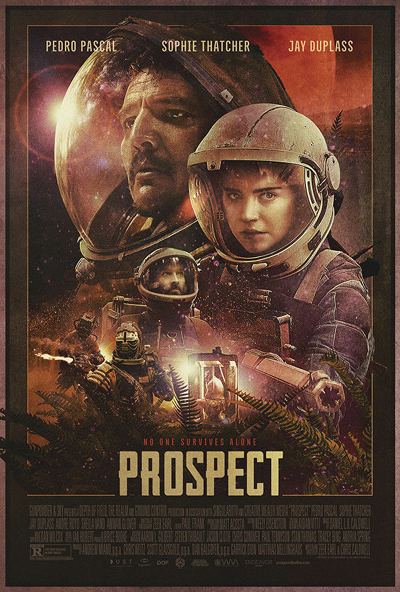
Mladen’s take
Del, though praising “Prospect,” has failed to adore this terrific piece of sci-fi sufficiently. B+ my ass. The sleeper film is an A top to bottom, left to right, and diagonally. “Prospect” is intimate sci-fi such as “Sputnik,” “Arrival,” or “Children of Men,” albeit less provocative intellectually.
There are nothing but exemplary performances in “Prospect.” Where Del chooses Pascal portraying Ezra as the show stealer, I give Thatcher’s Cee equal billing and praise.
Ezra is cunning, but abides the thief’s code of right and wrong as a “fringeling” prospecting and “digging” for gems created by living organisms. I wonder if the beasties, which eat limbs if improperly neutralized because accessing their “aurelac” requires sticking arms into their mouths, were modeled on oysters. Like oysters produce pearls from grains of ingested sand that irritate them, the whatevers on Green seem to create fist-sized aurelac the same way. Neat idea.
Ezra is a well-spoken rogue with boundaries. He has a chance to shoot Cee during a tumultuous encounter, but doesn’t. The way he demonstrates aversion to killing a child is wonderful. Nor did he sell her to god-fearing, convoluted-thinking, brazenly hypocritical religionists for a case full of neatly packed aurelac.
Cee’s reaction, measured in facial expression, when the religionists offer Ezra gems for the “girl” is compelling and authentic. It’s as though the youngster was able to imagine herself actually getting sold like property. Thatcher as Cee demonstrates uncanny acting again and again. From getting high chewing laced gum to a subtle hint of calculation and greed when Ezra offers her the prospect of collecting a fortune in aurelac to the way she urges him to keep moving with the wave of the rail gun in her hand, Thatcher is perfectly comfortable with her role as a resourceful teenager with still girlish interests. Why hasn’t she appeared in more movies? Give me more Pascal, while we’re at it. Caldwell and Earl get your asses in gear and make another movie as excellent as “Prospect.” Feel free to use Thatcher and Pascal again. They were a charismatic de facto father and daughter in “Prospect.” I imagine they could be, say, an effective mercenary duo on Earth or beyond fighting for Mankind’s survival. Maybe giving Thatcher the role of a queen reclaiming her kingdom from an alien race known as the Grist. Pascal could be a cyborg playing both sides until he witnesses the horror of Grist assimilating people.
Directors Caldwell and Earl understand that the guts of a movie is the story as captured by a good script. Visual effects can augment, never replace, solid writing and acting. In “Prospect,” the VFX are spot-on. A worn-down hi-tech world is assumed. The sound effects – the thunk of lander latches releasing, the rumble of thrusters, materials vibrating during re-entry, the clanking of “thrower” projectiles sent into hypervelocity motion – are very good, too. A soon-to-be-discontinued commuter line runs to the aurelac moon. Why discontinued? Probably because it’s no longer profitable now that the gem rush has come and gone. Who gives a shit about flora and fauna on Green, or studying it, when there ain’t no more money to be made? As the major points out in the less good, though still worth watching “Ad Astra,” humans are world eaters. Always will be.
“Prospect” is the whole works wrapped into a precise and efficient plot. The whole works includes the score. I paid attention to the soundtrack watching the movie and I listened to the soundtrack as its own medium. It’s very, very good. Have to hand it to composer Daniel L.K. Caldwell. He chose the correct orchestra and boys choir to immerse me in the moodiness of the story.
Yup, this film will be added to my Blu-ray collection. It’s that good.
Mladen Rudman is a former journalist and technical writer. Del Stone Jr. is a former journalist and author.

Image courtesy of eOne.
“Your Son” (“Tu Hijo”) starring Jose Coronado, Ana Wagener, Asia Ortego. Directed by Miguel Angel Vivas. 103 minutes. Rated TV-MA.
Del’s take
It isn’t often a movie pisses me off. I hated “Natural Born Killers” so intensely I wrote a newspaper column about it. Unfortunately, “Your Son” falls into that category.
The movie is well made but I’m not going to give it a favorable review. I thought it was a useless piece of shit, not only unworthy of the time I spent watching it but a detriment to the human experience.
The story takes place in the Canary Islands where a successful surgeon (Jaime Jimenez, played by Jose Coronado) has just saved the life of a young boy. The surgeon, who is married with two kids, receives the desperate gratitude of the boy’s parents with the understated (and possibly condescending) humility of a man who’s often sanctified by overjoyed relatives when the prognosis results in the patient remaining on this side of the dirt.
That comes screeching to a halt when his own son Marcos (Pol Monen) appears in the ER. Marcos has had the living shit beat out of him, and floating around out there is a video record of the crime. In an instant Surgeon Jaime Jimenez is deprived of his calm, confident control over events and must trust his son’s fate to other surgeons and the cops investigating the assault.
Or must he?

Thus begins Dr.Jimenez’s odyssey for revenge. Suffice it to say things are not as they seem. Both Dr. Jimenez and the audience will receive a brutal instruction in the shortcomings of human moral anatomy.
I’ve seen movies like this, and some of them can be entertaining as hell. “No Country for Old Men” comes to mind. But something about “Your Son” triggered my anger reflex. Maybe it was the horribly sexist male-centric point of view, or the “What if it were YOUR son?” question the movie seems to ask.
Speaking to that point, I would answer that if it were MY son, I wouldn’t have done ANY of the things Dr. Jimenez did. Not one. His actions seem born of a monstrous selfishness I can’t wrap my brain around. Worse, the movie, by not exploring anything beyond Dr. Jimenez’s immoral choices, seems to approve of them, as if no reasonable person could have reacted otherwise. Seriously, what would you have done if it was YOUR son?
What a crock.
I think my overall objection has something to do with the fact that in every movie about man’s capacity to be a shit to his fellow man, the story always proceeds from the assumption that, hey, these things are wrong, so don’t do them. I don’t think “Your Son” does. I think its moral center is agnostic, which sounds fine for a psychiatry thesis but sucks for entertainment.
As I said, the movie is well made, albeit slow to the point of boring throughout much of its running time. The actors do a fine job. The script is well-written. The tone is consistent with the theme.
But “Your Son” is a piece of shit. I hated it, and I won’t recommend it.
I’ll give it a C-, because despite its vile message, it’s a well-made film.
Del Stone Jr. is a former journalist and author.

Image courtesy of Benaroya Pictures.
“Haunting on Fraternity Row” starring Jacob Artist, Jayson Blair and Shanley Caswell. Directed by Brant Sersen. 99 minutes. Rated TV-MA.
Del’s take
There’s no explaining my Netflix whims, but they have introduced me to surprisingly good films (“Troll Hunter, “Birdbox”) and some real stinkers ( “Open House,” “IO”).
Then there’s that gray area between, where movies that are neither good nor awful fall. “Haunting on Fraternity Row” fits that realm. You can’t expect much from a movie with the word “fraternity” in its title and “Haunting” doesn’t provide much. It’s a frat party punch bowl of clichéd characters and their predicaments that you have seen a thousand times before minus these silly details.
The story is about a group of frathouse seniors on the day of their last big bash before graduation, the annual Luau Party. They want this to be a party for the ages because although it’s never said, they seem to collectively understand their time together is soon to end and they don’t want these days to be forgotten (although they will). So the boys are busy abusing pledges, stocking the shelves with booze and kegs, setting up Hawaiian-themed decorations and flirting with sorority cleaning girls.
Speaking of kegs, the hapless pledges drop one down the basement stairs and it punches a hole through a wall, revealing a tunnel that opens into a scary room with scores of light fixtures. One of the boys refers to it as a place where “you can’t see your shadow.” Oooh-weeee-ooooh.

The room is quickly forgotten as party time approaches. Tiki torches are lit. Sand is poured for the “beach.” A slaughtered pig makes its way to the roaster. And did I mention booze? Oceans of booze – the entire output of a brewery and a distillery – is laid out in astonishing plentitude. It’s like Golden Corral buffet for alcoholics.
Frat brother Dougie (Ashton Moio), meanwhile, has been researching the house’s past and learns that a terrible event took place here decades ago – the owner at that time invited a group of people to dinner and slaughtered them. Dougie thinks the creepy room may have some larger significance than a room where a person can’t see his shadow.
The party commences, with all the alcohol-fueled, sex-starved antics you know to expect from countless movies about frat boys and the sorority girls who love them – until all hell breaks loose, and I mean literally breaks loose. Objects move, mysterious growls emanate from the shadows, and people start dying, their eyes seemingly burned from the sockets.
I won’t tell you what happens afterwards should you decide to throw away an hour and a half of your life on this movie. Suffice it to say “Haunting” has more vices than virtues. It is sometimes amusing (but not often enough), sometimes spooky, and it might just remind you of a college experience or two (not me – I commuted).
Notice that damning with faint praise? That’s because “Haunting” is mostly a hastily assembled mashup of hackneyed characters doing what hackneyed characters do – except they’re doing it in a horror movie. That might work with sufficient camp (“Happy Death Day”), but the laughs are about as unlikely as any of these dimwits getting a job after graduation.
You’ve got the rich asshole and his catty sorority girlfriend, the hunk who’s dumb as a brick, the fat pledge, the nerd pledge, the smart frat who uses his powers for, well, neither good nor evil, but nothing productive either. Then you’ve got the earnest, soulful frat, Jason (Jacob Artist), and the girl he’s crushing on, Claire (Shanley Caswell). Jason is too shy to make his move but Claire is patient and awaits his stiffened courage (not what you think) while the other boys rollick in the receding tide of hormonal sex addiction (they are about to graduate from college, after all). Will Jason and Claire hook up? Will Dougie get to the bottom of the frathouse murder mystery?
And who’s going to clean up this mess?
I didn’t much care for “Haunting.” Characters are thinly sketched. The house’s backstory is barely touched. A motivation for the “haunting” is absent. Director Sersen seems to care more about scenes of college debauchery and raunchy dialogue than telling a decent ghost story.
It’s all very cursory and sketchy. I wasn’t scared because I didn’t care about anybody. You won’t either.
For a sparse moment of fun check out “Haunting on Fraternity Row.” I caught it on Netflix, where all it cost me was 99 minutes of boredom.
Grade D+.
Del Stone Jr. is a former journalist and author.

Image courtesy of Severn Screen.
“Apostle” Starring Dan Stevens as Thomas Richardson, Michael Sheen as Malcolm, Richard Elfyn as Charles, Paul Higgins as Frank, Bill Milner as Jeremy, Catrin Aaron as Elaine, Lucy Boynton as Andrea Howe, and others. Directed by Gareth Evans. 2 hours, 10 minutes. Rated TV-MA. Streaming on Netflix.
Plot summary: A man goes undercover to rescue his sister from the clutches of a religious cult that has taken up residence on a secluded island. During his attempt to free his sister he discovers a horrifying secret being kept by cult leaders.
Are there spoilers in this review: Yes. Read at your peril.
Del’s take
“Apostle” is two movies in one.
On the surface it’s a high-tension thriller about a man trying to rescue his sister from the clutches of a religious cult. But it’s also about a uniquely weird and horrifying supernatural secret being kept within the bleak, windswept hills of a deserted island.
I should have saved this review for Halloween because “Apostle” would fit that bill perfectly – as scarefests go it departs from the usual Spooky Season fare. You’ll find no unkillable slashers, shrieking ghosts or giant reptiles here. Instead, it’s a tense period piece from the debut of the previous century with a quietly anarchic feel, more reminiscent of “Midsommer” and “Wicker Man” than “Friday the 13th.”
I’m not familiar with Evans’ work but I am becoming a fan as “Apostle” is the rare movie that undergoes a tectonic shift in pacing and tone at about the halfway point, and somehow it all works. From quietly tense to madness, “Apostle” asserts the power of suggestion can be a dangerous weapon, but what lies behind that power could be even worse.
“Apostle” is also one of those movies where the setting abets the theme. It was shot mostly in Wales along the coastline and embodies the harsh, threadbare and downright mucky quality of life such locales had to offer in the early 20th century. Rocky coastlines flanked by fields of wiry grass giving way to dark, dank forests, operate as a kind of additional character in the story, similar to the way the cold and snow worked in the original “Let the Right One In.”
But it’s what lurks beneath those hills and forests that really drives the story, and while its presence is hinted at in the first half of the film, the second half becomes a quest to bring everything into the rational light of day while defeating the antagonists and acquitting the victims. At this point “Apostle” goes from slow burn to a furious boil of gore, blood, and horror layered upon horror, much like events leading up to the climatic scene in “Texas Chainsaw Massacre.”
All the actors were terrific in this film, but Dan Stevens’ desperate Thomas Richardson stands above the others. Also notable were Lucy Boynton as skeptical Andrea Howe and Bill Milner as the callow Jeremy. If I had to criticize the movie for anything, it would be the relative unlikability of Thomas, who seemed to hover somewhere between devoted rescuer and drug-addicted looney.
Mladen is already crabbing about it not having lots of foul language or sex. There are sex scenes, but I’d describe them as demur. As for the cussing, well, what can I say? This was turn-of-the-century England, not MAGA America.
I’ve watched movies that in one small way or another remind me of parts of “Apostle,” but I think it’s safe to say you’ve never seen anything like it. Evans tells a fascinating and entertaining story, one that’s worth your 2-hour, 10-minute commitment to watch it.
You won’t be disappointed.
Del’s score: B+
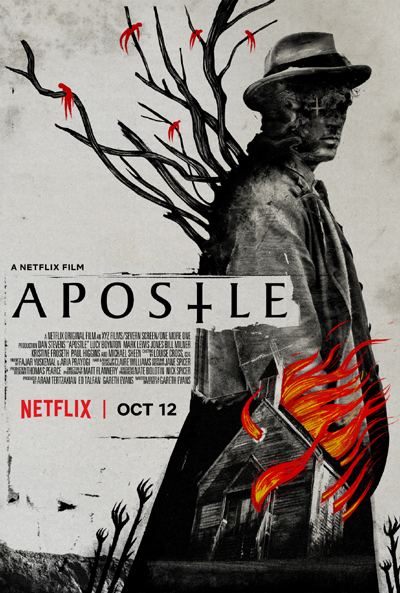
Mladen’s take
Speaking of MAGA. When I read Del’s summary of “Apostle,” I assumed the movie was about the Republican Party under Trump. I was mistaken. “Apostle” is tame compared to the back-stabbing, power-hoarding, hyper-erratic, yellow-bellied, proudly racist, and gullible males and females classifying themselves as GOP-ers these days.
Also mistaken is Del’s review of “Apostle.” It’s crappy and just barely more tolerable than torture movies such as “Saw” or “Hostel.” Only smart and beautiful redhead Andrea kept me watching because she bridged the gap between the film’s decent portrayal of cultism and its grotesque, nearly gratuitous descent into body horror starting with the brain drill.
The film’s most interesting character is religious sect prophet Malcolm (portrayed by Micheal Sheen). As the cult’s top religionist, Malcolm balances charisma, desperation, and dislike for needed violence, as he defines it, pretty darn well. His sole goal is keeping his colony functioning by eluding an impending doom even if that means shedding the Almighty for paganism. Now that I think about it, that’s interesting. The libertarian god of Malcolm’s beliefs most share space with the nature witch who control the island’s plant life.
“Apostle” costumes and bleak environment, mostly grays and blacks, suit the plot nicely as Del noted but other elements are askew.
First, there’s no way that turn-of-the-19th century Englanders, not to say self-exiled cultists living on the edge of poverty, had such perfect teeth.
Second, our protagonist Thomas is accidently the scariest person in the film. It wasn’t his opium addiction. It wasn’t that Thomas got a man murdered by doing a ticket switch to get on a guarded boat to the unholy island warren of Erisden. It was the persistent expression on his face, particularly the eyes. He looked evil with eyes always darting never blinking and, I don’t know, glowing preternaturally.
Third, where Del sees a wonderful transition from the film’s first half of seething, albeit, discreet menace and hypocrisy to a father murdering his teenaged daughter with a knife, then her teenaged lover with the hand-powered brain drill, then shooting Malcolm with a sawed-off shotgun, and then threatening sexy Andrea and Thomas’s sister, I see a movie running out of ideas to convey the dangers of cults and the rhetoric that inspires regular folk to dive into the deep end of an empty pool.
And, finally, I have no idea why the beast-man with his reed-wrapped head was needed. Yes, the soiled being, apparently, protected and fed the nature witch with blood and flesh from animals and then humans but from where did he come? Who or what was he? Why did Malcolm trust the beast man to care for the increasingly apathetic, or was it disillusioned, pagan who ran the island’s environment. I believe the beast man was inserted into the movie for on scene alone, the one where he tries to grind Thomas into food pellets and strips for the witch. Yuck and a repulsive yuck at that.
I agree with Del. Y’all probably never saw anything like “Apostle” and you may not want to.
Mladen’s score: A generous C because the first half of the movie isn’t bad.
Mladen Rudman is a former journalist and technical writer. Del Stone Jr. is a former journalist and writer.

Image courtesy of STX Films.
“Peppermint” Starring Jennifer Garner, John Ortiz, John Gallagher Jr., and others. Directed by Pierre Morel. 101 minutes. Rated R. Netflix.
Mladen’s take
Badass beauty Charlize Theron, a.k.a. Aeon Flux, Imperator Furiosa, Lorraine Broughton, etc., has serious competition. Who? Badass Beauty Jennifer Garner as Riley North in the pretty good Netflix flick “Peppermint.”
“Peppermint” has its weaknesses. Among those are its cliché good-guy/gal-seeks-rightful-revenge plot, a bit of maudlin nostalgia, the not infrequent appearances of the apparition of a murdered daughter, woke commentary on poverty, and the origin of the movie’s title. I’m sure even curmudgeonly Del, who, paradoxically, wants humanity in his movies, will agree with me on that. However, none of the above comes close to diminishing Garner’s exquisite performance as a mother pursuing justice very, very violently and the neat double-cross about two-thirds into the exactly correct runtime for this film.
I urge patience when you start watching this movie. The first third or so of the movie is dedicated to establishing the bad guys, a corrupt justice system, and the power and allure of money. The really good stuff starts with North’s takedown of a drunkard father in a convenience store. Loved it and the moral. It’s here that we get our first glimpse of the glib, witty, and rage-infused North. Garner delivers her lines convincingly. She metes righteousness in correct proportions. The shitty daddy is merely threatened with a 9 mm pistol stuck in his mouth. The drug-dealing gangbangers get the opportunity to meet bullets and shotgun pellets up close and personal. In between, North manages to avenge the slight of coquettish rich lady. The insult was delivered when North’s husband and daughter were still alive. North has a good memory, along with a body and temperament to take and deliver punishment.
Yes, “Peppermint” has its doses of bodies absorbing stunning injuries and the obligatory self-repairs of deep lacerations or punctures. I understand and sympathize with the troupe. I don’t know. Maybe from here on I should just rationalize moviedom abuse of the body and moviedom’s interpretation of how much abuse a body can absorb as the consequence of surging adrenaline. If you’re running with a dozen bullet holes through you or fighting with your guts spilling onto the sidewalk, it’s simply a matter of fact that your body hasn’t yet recognized that it’s dying. Hell, I don’t know why people are making such a fuss about legalizing recreational use of marijuana or other drugs countrywide. Give me synthetic adrenaline, damn it.
So, forget about Garner as “Elektra.” That’s polluted water, caused by the imbecile Trump and his administration of fools, under the bridge. “Peppermint” is Garner’s re-introduction as an action star. And, it works.
I was happy to see John Gallagher Jr. as Detective Stan Carmichael in “Peppermint.” You may remember Gallagher for his excellent portrayal of Emmet in the very good “10 Cloverfield Lane.” Gallagher’s Carmichael is a bit dopey, somewhat a slob, but likeable. He serves nicely as part of the narrative that explains Riley’s metamorphosis, while playing an important role in the story, as well.
Finally, there’s nothing special about the score for “Peppermint.” I interpret it as techno-poppy and raucous, but it failed to make an impression. Fortunately, neither did the score distract or diminish the film.
“Peppermint” gets a B. Garner gets a strident A. That would’ve been an A+ had she not balked. See the movie and you’ll know what I mean. There’s no way you or Del will disagree.

Del’s take
As of this writing “Peppermint” is “No. 9 in the U.S.,” according to Netflix. I tip my hat to the streaming giant. Americans do love their lists, and a list of who’s watching what on Netflix is sure to fire up page views for the lesser lights among its offerings.
Except it’s not really a “top 10 on Netflix” list. It’s a “top 10 on Netflix that are relevant to you” list, which means it’s pointless as a barometer of popularity. Yup. The algogremlin strikes again.
And here I was thinking “Peppermint” was a top 10 movie in the whole U.S. of A. despite its paltry $53 million box office take and 12 percent Rotten Tomatoes score. Why? Why is a 2-year-old movie suddenly popular on Netflix?
Turns out it isn’t.
I think Mladen has damaged his brain with all the “Ice Spiders” and “Snow Sharks” garbage he watches. On the luminosity scale “Peppermint” ranks somewhere between a searchlight and a miniature Christmas bulb. I lean toward the latter because truth be told, it’s little more than “Death Wish” retold without a trace of charm. No way should this movie be anything more than a time-killer when a body is waiting to be called into the doctor’s office for a hemorrhoidectomy.
Mladen also neglected to summarize the plot, which is this: Riley North sees her hubby and daughter gunned down by drug dealers because hubby (Jeff Hephner) refused to participate in a drug deal. The bad guys are caught, but the corrupt justice system lets them skate. North decides to take matters into her own hands.
Sound familiar?
Garner delivers a kickass performance, and for that I’m grateful. It made the movie for me. I do enjoy watching women like Charlize Theron and Rooney Mara mete justice to those who deserve a swift bust in the chops.
Also, there were some excellent visuals and fight sequences, particular the one in which the roles are reversed and it is the drug dealers’ bodies swinging from a bridge. I’d like to note Garner’s character was not one of those indestructible super-creatures who never gets stabbed, shot or beaten up. She suffers her share of damage, though her recovery time is a lot quicker than mine would be.
But everything else about “Peppermint” you’ve seen before – in my case over and over again. That’s not necessarily a bad thing. I can watch the same movie, or iterations of such, many times as long as they’re well done. In this case the plot relied too heavily on suspension of disbelief and hand-of-God intervention to leave me with a favorable impression.
I referred Mladen to “Peppermint” because I know he likes brain splatter and infrastructure destruction, although I don’t recall seeing either in “Christmas Chronicles 2.” But should you watch “Peppermint”?
My answer would be a qualified “maybe.”
It’s a simple-minded yet decent action movie with a hero who does not dodge all the bullets. But the plot is hackneyed and everything works out a little too adroitly to be taken seriously. I would look at it as a cartoonish rendition of “Skyfall” or “The French Connection.”
Going into “Peppermint” with that attitude will make it a more entertaining film.
Garner’s performance is a solid B+, but overall the movie gets a C from me.
Mladen Rudman is a former journalist and technical writer. Del Stone Jr. is a former journalist and author.
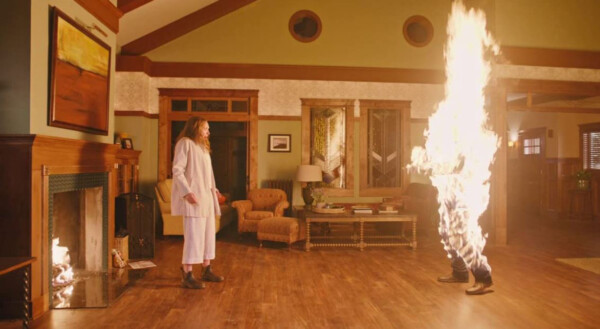
Image courtesy of A24.
“Hereditary” Starring Toni Collette, Gabriel Byrne, Alex Wolf and Milly Shapiro. Directed by Ari Aster. 127 minutes. Rated R.
Del’s take
“Kinda boring, isn’t it?” said the woman in the hallway as I headed for the men’s room. She had seen me coming out of the theater where “Hereditary” was about halfway through its 4:20 showing.
“It’s so very slow,” she continued as she headed back to the theater. Seems she was on her own bathroom break. But she was only partly right.
Said to be the “scariest movie of the year so far,” “Hereditary” is not just “kinda” boring. It’s VERY boring. The first two acts are thuddingly dull, and they’re followed by a third act mashup of horror movie clichés and a reveal that will have you asking yourself, “You mean, that’s it?”
The story begins with a funeral. Annie (Collette) is burying her mom, a miserable old bitch who made Annie’s life a living hell. In fact, Annie comes from a family of whackjobs – schizoids, paranoids and suicides – and now the last one has died. But with a title like “Hereditary” you know Annie’s life will never settle down to that pleasant myth of Americana depicted in every Norman Rockwell painting.
In fact, her current family is downright weird. Husband Steve is passive to a fault, letting every member of the family use him as a doormat. Big brother Peter is a pot-smoking cipher who has no purpose in life except that of professional victim. Little Sister Charlie is a strangely sociopathic oddball with no friends, no interests and no apparent redeeming qualities.
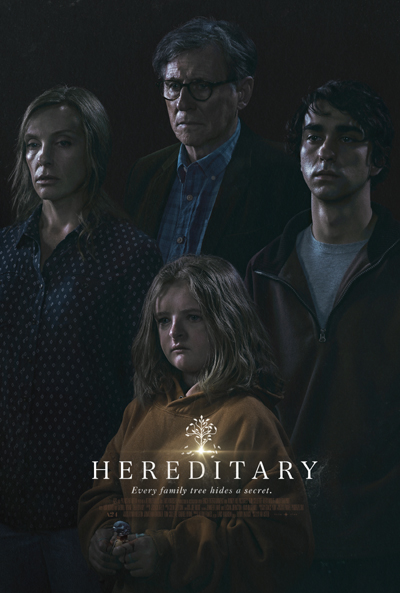
Annie herself is not exactly Mom of the Year material. She sleepwalks, at least once dousing the kids with paint thinner and trying to set them on fire. She re-creates various tragedies in her life as miniature models, an artform that has brought her a measure of acclaim, at least in the part of the world that appreciates depictions of headless children hanging out of the window of a Volvo stationwagon.
And there you have the first two acts of the movie – a slow infodump of all this boring background. The woman in the hallway almost got it right. Very boring.
I won’t tell you what happens in the third act because that would spoil it for you, God forbid you actually see this movie. But I will say this: Little girls crawling across the ceiling isn’t scary anymore. Candles suddenly spouting gouts of flame isn’t scary. Séances, furniture tipping over, flies in the attic – these things aren’t scary anymore because they’ve been done to death.
Collette is super as the besieged Annie. One scene, in which she’s having it out with her son over the dinner table, is Oscar-worthy in my opinion. And young Shapiro is nicely weird as the bird head-snipping Charlie. But Byrne and Wolff are less impressive, not through any fault of their own. Their characters are simply less impressive.
“Hereditary” isn’t scary. It lacks the tension of a good scary movie. And nothing is left to the imagination. You take a movie like “The Haunting,” “The Innocents” or even “Alien” – now THOSE are scary movies. They build their tension slowly and carefully, and they show you only hints of the Bad Thing, allowing your imagination to fill in the awful details.
If you’re in the mood for “Rosemary’s Baby” meets “The Exorcist,” by all means catch “Hereditary.” But prepare yourself for a long slog with a meager payoff. I’m pretty sure you’ll be disappointed.
I grade this movie a C.
Del Stone Jr. is a former journalist and author.